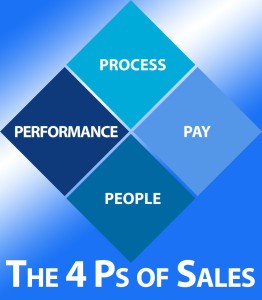 It’s no accident that the last “P” in my “Four Ps of Sales” is “People.” To see the right results from your sales, you need to have the right process in place first. From there, you need to figure out your optimal sales performance, and then use that information to establish what you can afford to pay for sales. Only after you have all that in place can you start finding the right people to plug into the process.
It’s no accident that the last “P” in my “Four Ps of Sales” is “People.” To see the right results from your sales, you need to have the right process in place first. From there, you need to figure out your optimal sales performance, and then use that information to establish what you can afford to pay for sales. Only after you have all that in place can you start finding the right people to plug into the process.
Salespeople don’t define your sales process. They’re a resource within the overall sales solution. They’re a critical resource, no doubt, but they need to be a part of a larger, highly organized and optimized system.
Too often, companies assume that hiring a salesperson means that the sales spigot will open and money will come flooding in. To an extent this is true, as a truly talented salesperson can create exceptional results for almost any business. It’s an appealing idea to just hire someone, plugging their experience and domain expertise to your organization. The downside, however, is that relying solely on those skilled individuals means that you’re essentially “renting” your sales competency. When you rent something, it’s not a permanent asset. When it goes away, it’s going to leave a void in the organization.
Without a clear set of criteria, hiring new sales staff is also going to yield marginal or poor results. Unless you have a plan, you’re essentially throwing warm bodies at the problem. This is an approach that ends up happening far more than it should in the business world. Simply hiring salespeople is never going to be the solution. Systems and processes are the solution, and your salespeople keep that sales engine running.
This doesn’t mean that finding the right sales staff should be a daunting task, however. Like the rest of this process, it’s mostly a matter of doing the right prep work to help you see the right results. The first step in finding out the right people to sell your stuff is to take a look at the process you’ve created, and look for people who fit into that process well. You also need to think about your company culture, and find people who complement it.
There are three main components in finding the right people: Qualities, Skill Sets and Compensation Requirements. Let’s take a look at the first of these, Qualities.
Qualities are the the softer stuff, consisting of personality traits and other intangibles. The obvious goal here is to find folks who possess the traits that you determine to be best suited to both the job and to the company’s culture. In order to do that, you first need to know what those traits are. Classic examples include traits like resourcefulness, problem solving, and good communication. In addition to that, I have my own list of qualities I look for in people I hire and work with, such as: self-starter mindset, tenaciousness, fearlessness, and a strong presence.
Another related kind of quality is the applicant’s “work/life fit” for the job. Travel is a good example of this. If the job requires 100-percent travel, it’s probably going to be a better work/life fit for someone who is a single and recent college grad, for instance. By the same token, it’s a less good of a fit for a single parent or a caretaker for an aging family member. For early-stage companies in particular, where the line between work and personal life tends to blur, this should be a serious consideration.
This is especially important in today’s hiring environment as more Millennials enter the workforce. They have different priorities and expectations, and there can be something of a clash of culture with the old “pay your dues” mindset. This isn’t a bad thing, but it can be a little frustrating if you’re expecting to find employees who are willing to keep their noses to the grindstone for 100 hours a week as a way of demonstrating their dedication. It’s a different generation, and it will be interesting to see how the interactions play out.
What about personality assessments like DISC or Myers-Briggs? While you can have your candidates submit to these profiles, I’ve found them to have limited real-world use. They’re also relatively expensive, and the results tend to be fairly clinical in nature, offering only a small amount of relevant insight about how well that person would integrate with your team. I’m a bigger fan of figuring this stuff out on your own. You likely already know the qualities that will work with you, your team and your company. Your gut instinct about a person is almost always going to be just as meaningful as a formal personality assessment.
In my next post, I’ll talk about the two remaining key parts of the “People” equation: Skill Sets and Compensation Requirements.
